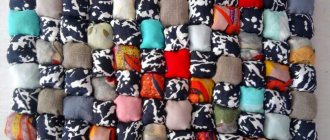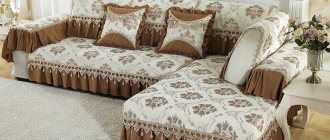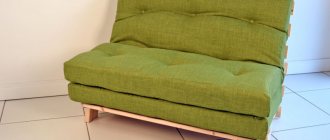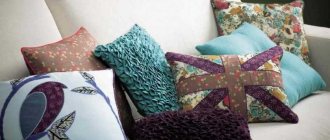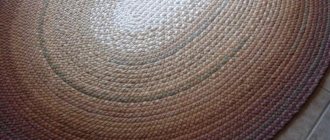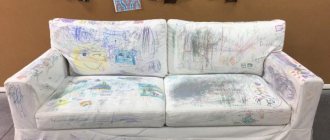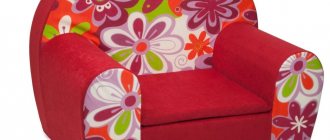How to calculate the amount of fabric for upholstery
A simple and affordable way to update your decor is to reupholster your upholstered furniture. New upholstery makes familiar objects attractive, refreshes the interior, and adds bright colors. The work of reupholstering interior items is transferred to the shoulders of professionals. Or they do it themselves. In the first case, the only task is to choose experienced restorers. In the second, you will have to stock up on measuring tools, tailoring supplies, fabric and a calculator.
The main thing is to correctly perform the preliminary calculation. Allowances for seams, margin for hemming edges and features of the print are taken into account: patterns that involve joining, clearly demarcated stripes, checks require matching the pattern on adjacent parts. Therefore, it is recommended to purchase the material in sufficient quantity.
How to calculate fabric for upholstery of furniture?
The algorithm for calculating the amount of fabric for upholstering upholstered furniture looks like this:
- Removing old upholstery (while maintaining the integrity of the parts).
- Measurement of received elements.
- Determination of width (the width of upholstery materials traditionally reaches 130-150 cm).
- Calculation of length (the sum of the vertical dimensions of the removed parts plus 20 percent).
- Calculation of the area of fabric for pillows (double the sum of length and height with the addition of 6 cm for allowances).
If it is not possible to remove the worn upholstery, perform the calculation using a different formula. The only necessary indicators are double the length and double the width of the product. The product of these values will become the required area.
When is a supply of furniture upholstery material needed?
Furniture of complex shapes, with a large number of decorative elements, requires attention when calculating the material. Experienced cutters recommend purchasing fabric for it with a margin of at least 30 percent. The same approach is required:
- sofas and armchairs with thick backs and seats, massive soft armrests;
- pieces of furniture, parts for which are adjusted on site (in the absence of a pattern or elements removed in advance);
- products that are subsequently subject to local restoration (the reason for far-sightedly planned repairs are children, pets, and permanent exposure to ultraviolet radiation).
Excess material will be useful for making decorative pillows and supporting bolsters. The decision to buy fabric with a reserve will be the right one. And the desire to save money will lead to the discovery of a shortage of material in the midst of work.
We are always glad to see you! Call!
8 8 8 8 8
We are in social networks:
If you are already registered on our website, but have forgotten your password or have not received a confirmation email, use the password recovery form.
Easy way to calculate
Calculating the amount of upholstery material for a chair or sofa is easy. First you need to remove the old upholstery from the furniture, arm yourself with a tape measure, and measure all the parts. If they are irregular in shape, their overall dimensions should be measured at the widest and longest parts. Then you need to add up all the vertical dimensions of the parts and add 20% to them (allowances, pattern alignment). This is how the required amount of fabric is calculated in centimeters (length). The width of the fabric is determined by the widest part. Typically, upholstery materials have a width of 130-150 cm. To understand how much fabric is needed for pillows, you need to measure their length, height, add these values and multiply the sum by two. To the result obtained, you should add another 5 centimeters for allowances. It is much more difficult to calculate the required amount of fabric if you do not remove the old upholstery. In this case, calculations are only approximate; one should proceed from the double length of the sofa (chair) and its double width.
How to upholster a sofa or photo instructions for reupholstery Part 2
After carrying out the preparatory work for reupholstering, you should calculate the cover for upholstered furniture. Upholstering a book sofa will not cause you any particular difficulties, but for covers of complex shapes that have large armrests or corner sofas, careful calculation of the pattern of the future cover is necessary. Having chosen the desired type of fabric, you can roughly calculate the material consumption based on the sum of double the width and double the length of the sofa .
For an accurate calculation, measure the old cover or use a tape measure to measure the dimensions of the sofa, which after restoration of the frame may differ slightly from the old dimensions.
Take fabric with a margin of 20% more than necessary. If there is any excess fabric left over, it can easily be used to make decorative pillows.
For example, if a sofa is 1.6 m wide and 2 m long, then a piece of fabric 7.2 m long will be used with a standard width of 1.5 m. In each individual case, it is better to measure the upholstered furniture. For corner sofas you will need much more stock. If this is your first time making a pattern, then measure each detail separately and apply their designs on a checkered piece of paper, taking into account the split line. For patterned fabrics, be sure to consider pattern matching.
If the geometric image is not covered, for example, with stripes, the work becomes more complicated. In this case, the cost and price of upholstery increases, since the strip must not only be directed in one direction, but also the back and seat of the sofa must match the pattern. If you have no sewing experience at all, we do not recommend choosing such fabrics. Upholstering a sofa from plain fabrics or those that have a small pattern will not take you much time or effort. The rule when buying fabric for a cover “+1 m” works; there will be no excess material here, since it’s worth thinking about its supply for minor repairs to individual sections of the sofa in the future.
Making a pattern can be similar to the old cover, if you removed it carefully, or creating a new one. After drawing up the card, cut it out on paper and transfer it to the back of the furniture fabric using chalk, taking into account the direction of the cut. It is always necessary to leave seam allowances, and they range from 2 to 5 cm. A few more cm will be spent on folding the fabric for fastening with a stapler. Each sofa is unique in its shape and size, so there is simply no universal pattern. But there are some tips that will help you to reupholster your sofa:
- Large allowances will allow you to form a pattern directly onto the product; cut off the excess with scissors.
- The more tightly you plan the pattern, the greater the likelihood of making mistakes, especially for a sofa with a complex shape. Even with the rectangular appearance of the sofa, its cover can be quite difficult to manufacture.
- The cover must initially be made free, because the upholstery of the sofa in the workshop is not done according to strict patterns, but the fabric is stretched and nailed with nails or staples. The free case will give you the opportunity to form the final shapes directly onto the product.
How many meters of fabric are needed to reupholster furniture?
Strange as it may seem, the most important part of the work when reupholstering a sofa or chair is marking . It is necessary to mark the fabric as accurately as possible so that there is not only enough for covering, but even with the slightest mistakes the material does not suddenly run out, that is, you need to take it with a reserve. Very often, when reupholstering furniture, beginners make the most basic mistake at this stage - on the markings.
To avoid this trouble, you need to treat calculations with the utmost care and rigor. It will be very unpleasant when, having bought material in a store, it suddenly turns out that there is not enough of it to completely reupholster the furniture. Especially if it is not possible to purchase the missing material, for financial or any other reasons.
In order to sew a cover, you should prepare everything you need:
- A piece of fabric from which the rough cover will be sewn;
- Beautiful fabric for sewing the cover itself;
- Lightning ;
- Centimeter to measure material;
- Pencil and chalk;
- Eye pin;
- Needles, threads, cord for kata;
- Furniture staples;
- Sewing machine .
To more accurately calculate the size of the fabric, you need to measure the width and length of the furniture. If you do the calculations roughly, it should look something like this: 2 lengths plus two of its widths. Without some experience it is impossible to make more accurate calculations. It is better to measure all parts and areas several times. Each part is measured separately.
Reupholstering of upholstered furniture includes replacing the filling, replacing damaged parts and mechanisms, and repairing the frame. The easiest way is to leave the frame from the previous furniture and sew covers on it, replace the sagging filling.
Particular attention should be paid to the choice of fabric. If you have pets at home, we strongly recommend that you pay attention to the section Anti-vandal fabrics ; this section presents fabrics with a high wear cycle , more than 40,000 cycles according to the Martindale test.
Anti-vandal fabrics are designed for increased use at home.
Fabrics marked Anti-claw are fabrics that are resistant to the claws of pets.
Remember!
Giving new life to old furniture is much cheaper than buying new furniture.
How to choose the right upholstery fabric?
We advise you to choose a high fabric density of 350 g/m²; this density is suitable for heavy-duty furniture in public places. Generally, high density fabrics are of higher quality.
If the restored furniture is to be placed in a children's room, it is necessary to use only natural, hypoallergenic materials that are easy to clean. We monitor the quality of the fabric we offer; all fabrics in our store are hypoallergenic and also have a certificate of conformity.
For living room furniture, we recommend choosing fabrics that are easy to care for and durable. Suitable for you: flock, chenille, jacquard, tapestry, velor, artificial leather, microfiber.
Upholstered furniture on which people sleep should be upholstered in wear-resistant fabric with natural threads. Jacquard, chenille, tapestry, velor, microfiber meet these requirements.
How to calculate the required amount of fabric?
For an approximate calculation, multiply the sum of the length and width of a piece of furniture by 2. So, for a sofa with dimensions of 1.6 × 2 m you will need more than 7 linear meters of fabric.
This drawing will also help you determine the approximate yardage of upholstery fabric:
So, for a chair you will need from 2.7 m (for the simplest) to 7.5 m (for a chair-bed) or 8.2 m (for a chair with a pouf). For chairs you need 2–3 m of fabric, for poufs 2–5 m. For a sofa you will have to purchase from 2.7 m (compact simple) to 31 m (double corner).
For a more accurate calculation of furniture fabric, take measurements of all parts of the furniture: seats, backs, armrests, pillows. Then schematically transfer the details onto paper and indicate the dimensions. In this case, in the figure, the vertical elements should be positioned vertically, and the horizontal elements horizontally. Be sure to add 3-4 cm for bends, seams and new filler.
The width of the future cut will be equal to the maximum value of the obtained horizontal dimensions. And the length will come from the sum of the lengths of the vertical dimensions of all parts. For every 5 m of fabric, it is recommended to add another meter for edging, matching the pattern, and so on.
Selecting fabric for upholstery
The fact is that today the textile industry offers the widest selection of various furniture fabrics. Each has its own technological characteristics, strength indicators and functionality.
For example, natural does not mean that the fabric is practical. A new sofa with tapestry or jacquard may quickly require repair. If not properly cleaned, they shed and, of course, lose their appearance.
Fabric characteristics
Flock fabric is suitable for those owners who have pets in the house. The density of the texture protects the top layer from so-called snags.
From the above, it is clear that when buying fabric for yourself, you should not immediately take the first one you come across just because you simply liked it. Be sure to consult with the seller about the characteristics of this fabric and its operating conditions.
Material for reupholstering a sofa that craftsmen use:
Features of furniture fabrics that everyone needs to know:
- Glue-based chenille - dry cleanable. If wet processing is used, it may become deformed and take a long time to dry.
- Fabric-based chenille is moisture resistant.
- Microfiber – abrasion resistant. Not recommended for allergy sufferers as it may cause attacks.
- Flock is a completely synthetic material. Cleans well, does not cause allergic reactions, and due to the density of the thread weaving, it is recommended for those who have pets.
- Anti-claw is a very durable fabric. It is used as protection against pets, as well as various mechanical influences (cuts, punctures, tears). Due to the short pile and dense texture, the possibility of snagging and deformation of the fabric is eliminated.
- Tapestry is 80% natural material with the addition of synthetic thread, which gives it strength and wear resistance. There is a single-layer and two-layer tapestry, with a pattern and plain.
- Matting is a fabric that is especially popular because it has a durable base and an attractive appearance. In interior decoration in the “ethno” style, its appearance resembles burlap.
Material
For upholstery, buy furniture fabric that:
- keeps its shape;
- easy to use;
- tear-resistant;
- resistant to mechanical damage.
The choice of texture, density, pattern depends on the interior, color of walls, curtains, other furniture, etc. For correct calculation, the characteristics of the material are taken into account. For example, when working with pile fabrics, you need to monitor the direction of the pile. The shade and location of the patterns depend on it. The use of fleecy fabrics increases material consumption by 10-15%. Fabrics with a directional pattern for upholstering a straight sofa should be cut in one direction. If there is a large pattern on the surface, it is placed in the center of the furniture. To combine the pattern you will need a lot of fabric, which increases the consumption by up to 30%.
Using multiple blades also increases consumption by up to 20%. This value is relative and varies depending on the type of furniture and the location of the patterns. The most economical is the use of artificial leather, fabrics that do not have a directional pattern, or pile. In this case, the pattern is located in any direction.
The most common ones for upholstery of upholstered furniture are:
- scotchgarden. Durable, easy to clean, pleasant to the touch. Made from natural fibers;
- velor (micro-velor). During the production process, natural and synthetic fibers are mixed, which ensures the strength of the fabric and environmental safety. Used for finishing furniture in the office, bedroom, living room;
- jacquard. The most durable and beautiful material. The threads are tightly intertwined, which ensures high tensile strength, resistance to mechanical damage and heavy loads. Does not fade, retains its original appearance for a long time;
- thermojacquard. A new type of upholstery fabric, during the manufacturing process of which thermal paper is applied to classic jacquard. The dye penetrates deep into the fiber and is fixed. The material is cheaper, but has all the characteristics of jacquard;
- chenille Synthetic material that does not retain moisture;
- arpatek. Synthetic fabric that looks like leather. The fabric is resistant to temperature changes, moisture, and direct sunlight.
In addition to those listed, natural and artificial leather, flock, corduroy, suede, etc. are used for upholstery.
When answering the question of how much fabric is needed to upholster a corner sofa, the dimensions of the furniture, texture, pattern, and elasticity of the fabric are taken into account.
Required Tools
The first tool needed to sew a strong cover is a high-quality sewing machine that can easily handle materials of any thickness and density. You will also need:
- wrench, screwdrivers for separating furniture elements;
- stapler with staples;
- pliers, hammer with small nails;
- screwdriver;
- scissors;
- glue;
- meter or tape measure.
How to take measurements and make markings
With the right cut, you can save a certain amount of fabric, which is enough for additional accessories: pillows, poufs, bolsters.
The first thing to do is remove the fabric from the sofa, keeping the old cut.
It is from this that we will make patterns. Those. Our task is to remove the fabric without damaging its overall dimensions. This can be done using a flathead screwdriver or pliers. With their help, we carefully remove the staples and put them in the designated place.
After we have pulled out all the staples and freed the fabric, we use a blade to sew out all the existing seams (longitudinal and corner).
We get individual parts, which we economically lay out on new fabric.
Some craftsmen, in order to maintain extremely accurate dimensions, steam the old parts and then iron them. This way we get very convenient blanks for outlining; the edges are smooth and do not curl.
Using flat chalk or a felt-tip pen, we outline the old details on the new fabric (for convenience, the fabric can be laid out on a regular home table).
Next, all we have to do is cut out the necessary blanks with scissors along the drawn lines and we can start sewing the parts into covers.
The details must be numbered so as not to get confused in the future.
Sewing covers
- It is advisable to baste immediately in place, this way you can achieve the most accurate fit of the part. To prevent the fabric from slipping on the surface, we fix it with marker needles or sewing clothespins.
- After all the parts are sewn into a common case, you can do the fitting.
- The final stage will be sewing on a sewing machine. Here you need to take into account all the additional details: zippers, piping, stripes, ruffles, etc.
If you do not have sewing skills, this can be done by a professional seamstress at home or by craftsmen in any sewing studio. To do this, they just need to provide old parts, from which they will make precise blanks and sew covers.
Installing the cover on the frame
The cover is placed on the sofa and turned upside down.
This is the standard position for fixing it. We pull the rest of the fabric, this is about 4-5 cm, towards ourselves, but so as not to overtighten, and use a stapler to hammer the staples into the folded fabric.
We punch each subsequent staple at intervals of 3-4 mm.
Uniform tension of the fabric over the entire area is achieved due to some nuances of its “shooting”:
- You need to fasten the fabric in four places of the frame frame, not reaching the corners by about 5-6 cm.
- The corner parts are fixed last.
The photo shows a simple method for making corners:
If for some reason it is not possible to accurately calculate the old cut, you can use the presented fabric consumption table:
If this is a furniture corner, then divide the amount of fabric for the sofa in half
Using this table, you will approximately understand what yardage of fabric you will need for your type of sofa.
Features of the formation of the price of work for different elements of the structure
Foundation
Before starting calculations, you need to decide on the type of its design. The settings of our computer provide the following foundation options:
- strip on stilts;
- tiled monolith;
- monolith with a base;
- with a ground floor.
The design is selected taking into account the mass of the designed structure and the geological features of the soil at the site.
Next, for calculations, you need to indicate the dimensions of the desired building (width, length) and the thickness of the foundation. We get three numbers: the price of the work, the cost of materials, the final cost. This result will appear at every stage.
The scheme is similar. We choose which walls we will build and the height of the floor. We suggest paying attention to:
- cellular concrete blocks;
- walls made of ceramic bricks;
- porous ceramic blocks.
It is worth knowing that the calculator will calculate the construction of a house from blocks to be slightly more expensive than in the case of brickwork. But we advise you to initially choose material based on characteristics, not price.
Floors
The construction of floors is of particular interest due to its ability to combine various options. The online construction calculator offers you to select floors for the basement and floor separately. Also note the difference in design:
- wooden or glued beams;
- concrete slabs or monolith.
In your choice, it is important to proceed from the general requirements for the structure under construction and financial capabilities. With proper selection of floors, you can even save money. For example, it is better to use concrete between the basement and the first floor. The house will be better protected from moisture coming from below, and the floors will withstand more weight. Wood can be used as the basis for the attic floor, which is less durable than concrete, but cheaper. This will also improve thermal insulation.
If you want to be as safe as possible in terms of fire safety, it is better to turn to concrete partitions. However, here it is important to take into account the capabilities of load-bearing structures (foundation, walls) in terms of withstanding significant loads.
Roof and chimney
The difference in their range is only in price and aesthetics. The elements fully perform their functions, regardless of price. Pay attention to the following types of tiles:
We invite you to familiarize yourself with Fireproof fireproof sheet material for doors - Articles
- natural;
- composite;
- bitumen (soft);
- metal.
The latter option is characterized by the greatest prevalence in modern construction. The chimney pipe can be chosen from brick, ceramics or stainless steel.
Ladder
The staircase is one of the elements of the house that cannot be defined by volume. An online calculator for calculating the construction of a house determines the price of stairs based on the material of manufacture and the number of floors. They can be wooden, metal, monolithic (made of reinforced concrete).
Windows, doors
• When cutting pile fabrics, it is necessary to ensure that the pile faces the same direction on all furniture, since the fabric has different shades along the pile and against it. This imposes certain restrictions on the location of patterns. The use of such materials does not increase material consumption significantly - approximately 10-15%
• Materials with a directional pattern must also be cut in one direction.
• A large pattern on the fabric is usually located in the center of the furniture. To combine patterns, you have to make fairly large cuts, which increases the consumption of material, sometimes very significantly. Therefore, if there is a need to upholster furniture with the least amount of material consumed, then try to avoid choosing material with a large pattern, as its overconsumption can reach up to 30%.
• Combining materials also increases material consumption by approximately 15-20%. But this is an approximate value - it all depends on how the patterns are arranged.
• Leatherettes have the most economical cutting. Since, in most cases, there is no directional pattern on the material and there is no need to select the direction of the pile. The pattern pieces can be placed in any direction.
What is sofa reupholstery?
Over time, upholstered furniture loses its aesthetic appearance and functional characteristics due to daily stress during use. Incidents happen especially often when there are small children and pets in the house. Updating a sofa may consist of various stages depending on the amount of damage:
- Upholstery fabric is replaced when the old one has stubborn stains, cuts, abrasions, or you want to update the interior without significant investment. This is the easiest repair option.
- Do-it-yourself furniture reupholstery may also include replacing the soft part if there are dented or deformed areas.
- Replacing the bottom of the frame or its other elements is rarely done, mainly for products that are of particular value to the owner. Such repairs will be comparable in cost to buying new furniture.
What do you need to reupholster a sofa?
Before you start reupholstering the sofa, you need to decide on the scope of work and prepare all the necessary materials and tools. It is better to change only the upholstery and lining fabrics, the soft part made of foam rubber or padding polyester on your own. More global repairs should be entrusted to professional furniture makers. Covering a sofa with your own hands is possible only after careful preparation of all the necessary elements:
- upholstery fabric of suitable quality, size and color for the interior;
- lining fabric;
- edgings;
- felt, padding polyester or foam rubber as a soft filler;
- zippers;
- decorative buttons;
- the necessary tools and equipment.
Do-it-yourself sofa reupholstery
High-quality reupholstery of a sofa with your own hands is carried out step by step according to the following instructions:
- The first step is to disassemble the furniture. All constituent elements are completely separated from the base.
- Next, the old upholstery is carefully removed.
- The condition of the foam rubber is assessed. It is better to replace worn material with new one.
- If necessary, the spring block and frame are repaired and strengthened.
- New patterns are cut out and a cover is sewn.
- The sofa is covered with new fabric.
How to measure a sofa?
Before reupholstering a sofa, you need to measure it and accurately calculate the required amount of material. This can be done as follows:
- Add the length and width of the furniture along the back, multiplying the resulting amount by two. The product will be the required length of the fabric piece. This method is applicable for simple rectangular sofas.
- Often, reupholstering furniture at home involves repairing corner sofas. In this case, you can conditionally divide the ottoman into two parts and measure the parameters of each, multiplying by two, and then adding the resulting numbers.
- Thus, a standard sofa may require from 10 to 17 m of fabric.
- Fabrics with large patterns and stripes are cut in one direction. In addition, it is worth considering seam allowances, so a one-meter supply of material will never hurt.
How to disassemble a sofa?
Another method for determining the required amount of fabric for reupholstering a sofa at home is to measure all the parts of the old upholstery. To do this, you need to disassemble the furniture, carefully remove the old cover and measure all the parts along the same directions. The parsing procedure is carried out according to the following algorithm:
- All pillows, bolsters and decorative elements are removed.
- The back and sides are separated using a screwdriver or special fasteners.
- Reupholstering a corner sofa, in fact, like the standard model, necessarily includes storing all the fasteners in a separate special container.
- Old upholstery is almost always secured with furniture staples. They are removed with an anti-stapler or a flat-head screwdriver. In particularly difficult cases, you can use pliers.
- Then the old soft material is replaced and new upholstery is sewn.
How to sew a sofa cover?
A standard replacement of sofa upholstery involves sewing a cover. If you have no experience working with a sewing machine, then it is better to entrust this work to a professional tailor. When sewing yourself, it is important to follow the following recommendations:
- The easiest way to cut out new fabric is to use the remaining parts of the old cover.
- If they are not there, then it is better to first draw the new elements on special cutting paper, taking into account all seam allowances.
- Afterwards, all drawings are transferred to the fabric, which has been previously ironed and turned face down, with special chalk.
- It is better to place the parts as close to each other as possible.
- Elements are always cut along the second line.
- The resulting patterns are folded face down and joined with temporary seams.
- The resulting cover is tried on the sofa.
- If the resulting product is suitable, then all seams are sewn down.
- The edges are folded, the seams are sewn down again, and their evenness is checked.
- All elements are sewn on a special sewing machine.
How to put a cover on a sofa?
Self-upholstery of the sofa is completed by attaching a new finished cover. This is one of the simplest and at the same time important stages, which is carried out according to the following algorithm:
- The new upholstery is attached to each piece individually on a smooth and level surface.
- You should start with decorative elements, then cover the seat, sides and back.
- All tension is carried out carefully and evenly, without folds or distortions. Reupholstering a leather sofa is carried out especially carefully, because the material is sensitive to mechanical stress and stretching.
- The cover is secured with a furniture stapler with staples approximately 14 mm long.
- Fastening starts from the middle.
- The distance between staples is no more than 4 cm.
- The final step is to secure the lining fabric from the wrong side.
Standard values
An experienced furniture maker only needs to glance briefly at a chair or sofa to tell how much fabric will be needed for the upholstery - of course, not exactly, with a margin. For example, upholstering an ordinary chair with a hard back will require about one and a half to two meters of fabric. A chair with a soft back will take 2-3 meters, a chair with small armrests will take at least 5 meters. A cozy chair with a high back, wide armrests, double seat cushions and small legs can be updated by using 7-8 meters of fabric. To cover a standard pouf, 2.5 meters of upholstery material is enough. Upholstering a sofa with armrests will take from 10 to 17 meters of upholstery material. The length of the piece of furniture should be multiplied by five (sofa with legs, no additional pillows) or by 6 (extra parts, many pillows, short legs).
Price per cover
Fabrics with a geometric pattern will significantly increase the cost of covering, since such fabrics can only be cut in a certain direction. It is better to choose plain fabrics with them and take less and it will cost less. A material with a small pattern would also be a good option.
After the measurements have been received, you need to transfer it all to paper. Draw separately each detail and its dimensions that were obtained earlier.
Leather upholstery
Basically, buyers choose between genuine leather and fabric, it all depends on the person’s financial capabilities. When purchasing genuine leather for your upholstery, you should focus on the elasticity of the material. Thick leather more than 3 mm will not be the best option, since it is quite difficult to work with. This is especially true for those moments when the purchased piece is not enough for full upholstery. Only a few centimeters may be missing and all because the skin is not elastic enough than necessary.
It is better to take measurements and sew dry leather. If the material is wetted with plain water, then after drying it will shrink and most likely stretch, so the skin should be dry.
